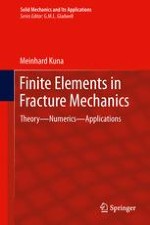2013 | OriginalPaper | Buchkapitel
5. FE-Techniques for Crack Analysis in Linear-Elastic Structures
verfasst von : Meinhard Kuna
Erschienen in: Finite Elements in Fracture Mechanics
Verlag: Springer Netherlands
Aktivieren Sie unsere intelligente Suche, um passende Fachinhalte oder Patente zu finden.
Wählen Sie Textabschnitte aus um mit Künstlicher Intelligenz passenden Patente zu finden. powered by
Markieren Sie Textabschnitte, um KI-gestützt weitere passende Inhalte zu finden. powered by
